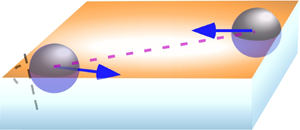Article contents
Pairwise hydrodynamic interactions of spherical colloids at a gas-liquid interface
Published online by Cambridge University Press: 25 March 2021
Abstract

Colloids which adsorb to and straddle a fluid interface form monolayers that are paradigms of particle dynamics on a two dimensional fluid landscape. The dynamics is typically inertialess (Stokes flows) and dominated by interfacial tension so the interface is undeformed by the flow, and pairwise drag coefficients can be calculated. Here the hydrodynamic interaction between identical spherical colloids on a planar gas/liquid interface is calculated as a function of separation distance and immersion depth. Drag coefficients (normalized by the coefficient for an isolated particle on the surface) are computed numerically for the four canonical interactions. The first two are motions along the line of centres, either with the particles mutually approaching each other or moving in the same direction (in tandem). The second two are motions perpendicular to the line of centres, either oppositely directed (shear) or in the same direction (tandem). For mutual approach and shear, the normalized coefficients increase with a decrease in separation due to lubrication forces, and become infinite on contact when the particle is more than half immersed. However, they remain bounded at contact when the particles are less than half immersed because they do not contact underneath the liquid. For in-tandem motion, the normalized coefficients decrease with a decrease in separation; they collapse, for all immersion depths, to the dependence of the drag coefficient on separation for two particles moving in tandem in an infinite medium. The coefficients are used to compute separation against time for colloids driven together by capillary attraction.
JFM classification
Information
- Type
- JFM Papers
- Information
- Copyright
- © The Author(s), 2021. Published by Cambridge University Press
References
REFERENCES
- 6
- Cited by


